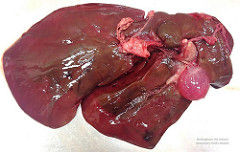This article has been inspired by several of our animal clients that have been dealing with liver disease. We all know the importance of this organ; in fact there is a phrase that goes “one cannot LIVE, without the LIVEr”. The liver in animals is no different. Despite being nothing more than a reddish brown mass with a tiny gall bladder attached, the liver performs hundreds upon hundreds of functions that keep you and your fluffball alive.
For starters, the liver metabolizes every macronutrient you put into your body. The liver processes all carbohydrates, fats, and proteins alike. All those supplements we take? The liver also processes those. This organ is a powerhouse when it comes to digestion and detoxification. Fat-soluble vitamins are stored, blood-clotting factors are produced, and albumin (an essential blood protein) is manufactured in the liver. If the liver begins to fail, so does the rest of the body.

One of the trickiest parts of monitoring the liver is the fact that it won’t show any signs of disease until something has been wrong for an incredibly long period of time. Unlike most other organs in the body, the liver’s multiple lobes all perform the same tasks, so when one begins to fail the others can compensate and keep the body functioning. Research has shown that this organ has such reserve capacity that when one or more of the lobes are diseased, the others can kick into overdrive instantly, allowing the body to continue as if nothing were wrong. Another liver trait is the ability for it to be regenerate. If a liver is failing and three of the four lobes need to be removed, the remaining lobe can pick up the slack while the other three begin to grow again. Within several months time a new liver will have replaced the previously removed tissue.
The liver is a wondrous organ and the list of its many functions abounds. With such a high functioning organ at stake, one can imagine how any type of malfunction here could be incredibly dangerous. One of the ways disease is spotted in the liver is through blood testing. When liver enzymes are high there is cause for concern. There are several avenues that can be taken to help regulate liver enzyme levels and get this organ back to normal.

Liver enzymes may be elevated because of a dietary issue. When an animal is not fed a species appropriate diet the liver has to compensate. Years of compensation can eventually lead to heightened liver enzymes. Aside from diet, liver enzymes may be high because the liver itself is diseased. If levels remain high and disease is not discovered despite appropriate nutritional components, something else may be going on.
How should this be addressed? There are all sorts of supplements and medications on the market to help with the liver. One of our favorite products comes from Nature’s Sunshine. This company is all about the herbs, each with different properties that act as detoxifiers as well as immune support. For instance, milk thistle is one of the absolute best options for liver detox. It promotes liver cell regeneration and stabilizes the liver cell membranes. In addition to that, milk thistle constituents will change the structure of the membrane disallowing toxins and poisons in. Below you will find some products I’ve found to be helpful for liver support.
There is so much to be learned about the liver and no two page article could even begin to cover it’s inner workings, however, we hope you’ve gained a little insight into the importance of this organ and will do your best in trying to keep it healthy!
Sources:
https://www.naturessunshine.com/us/product/liver-cleanse-formula-100-caps/1010/
https://www.naturessunshine.com/us/product/milk-thistle-combination-90-tabs/4076/
http://www.peteducation.com/article.cfm?c=2+2083&aid=514
Photo Credit:
RJN0002PM0026 via photopin (license)
RJN0002PM0036 via photopin (license)
Rolo via photopin (license)
DSC_8272_4621 via photopin (license)

